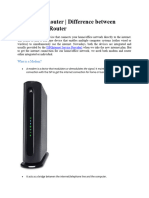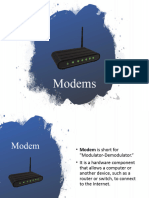0% found this document useful (0 votes)
51 views1 pageModem
A modem is a device that connects a computer to the internet by converting digital data into analog signals for transmission over telephone lines and vice versa. It is a separate hardware component installed in a PCI slot and comes in various types, including dial-up, cellular, and cable modems. Essentially, it serves as a translator between the computer and the internet, enabling data communication.
Uploaded by
tech4fresherssCopyright
© © All Rights Reserved
We take content rights seriously. If you suspect this is your content, claim it here.
Available Formats
Download as ODT, PDF, TXT or read online on Scribd
0% found this document useful (0 votes)
51 views1 pageModem
A modem is a device that connects a computer to the internet by converting digital data into analog signals for transmission over telephone lines and vice versa. It is a separate hardware component installed in a PCI slot and comes in various types, including dial-up, cellular, and cable modems. Essentially, it serves as a translator between the computer and the internet, enabling data communication.
Uploaded by
tech4fresherssCopyright
© © All Rights Reserved
We take content rights seriously. If you suspect this is your content, claim it here.
Available Formats
Download as ODT, PDF, TXT or read online on Scribd
/ 1























































































